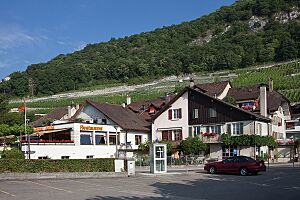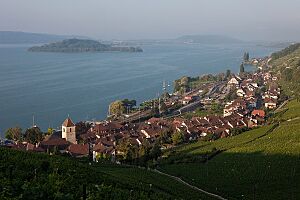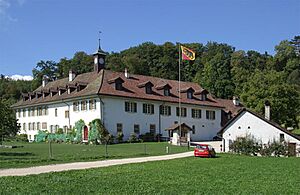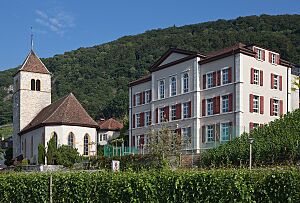Twann-Tüscherz facts for kids
Quick facts for kids
Twann-Tüscherz
|
||
|---|---|---|
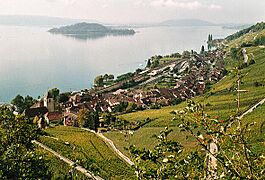
Twann village with Lake Biel/Bienne and St. Peter's Island in background
|
||
|
||
| Country | Switzerland | |
| Canton | Bern | |
| District | Biel/Bienne | |
| Area | ||
| • Total | 12.33 km2 (4.76 sq mi) | |
| Elevation | 434 m (1,424 ft) | |
| Population
(Dec 2020 )
|
||
| • Total | 1,171 | |
| • Density | 94.97/km2 (245.98/sq mi) | |
| Postal code |
2558
|
|
| Surrounded by | Biel/Bienne, Ipsach, Lamboing, Evilard, Nidau, Sutz-Lattrigen, | |
Twann-Tüscherz (also known as Douanne-Daucher in French) is a town in Switzerland. It is located in the Biel/Bienne area of the Bern canton. On January 1, 2010, the towns of Tüscherz-Alfermée and Twann joined together to form Twann-Tüscherz.
Contents
A Journey Through Time
Twann was first mentioned in old records in 1185. Tüscherz appeared around 1230, and Alfermée in 1276. These names show how old the area is!
Twann's Ancient Past
Near the Twann train station, there's a very old neolithic (New Stone Age) village site. It was found in the mid-1800s. Between 1974 and 1976, archaeologists explored about 10% of it. They found that almost 20 different villages existed here between 3838 and 2976 BC.
Each village only lasted for a short time, with the longest being 24 years. The small huts (about 7 by 4 meters) were temporary. They often needed repairs and were replaced after about 16 years. These huts were built close together, facing the lake. Their floors had a layer of peat (decayed plant material) to keep them dry. A clay fireplace was in the middle of each hut.
The people living here used simple tools like hoes and plows. They grew grains for porridge and bread. They also raised animals like cattle, sheep, and goats. When needed, they hunted wild animals, especially red deer. Fishing in the lake was also a common activity. They made clothes from woven flax and bark fibers.
Archaeologists found a special pot that suggests trade with people in Valais. A rock crystal shows they traded with other mountain villages. About half of their flint tools came from local sources. The other half came from far away places like southern Germany and France. They even found one copper knife blade!
Other old sites in the area include a Roman grave and early medieval finds.
Twann in the Middle Ages
During the Middle Ages, Twann was the main town of the Lords of Twann. After their family line ended in 1250, the area changed hands several times. By 1470, the right to hold a court in Twann was shared between Bern and the Prince-Bishopric of Basel.
The village church, St. Martin, was first mentioned in 1228. The first church building was from the 9th or 10th century. It was rebuilt in the 13th and 15th centuries. The church looks as it does today because of a renovation in 1666-67. In 1528, during the Protestant Reformation, control of the church went to Bern.
Life and Work in Twann
The local economy mainly relied on viticulture (growing grapes for wine), fishing, and raising animals. People would go to weekly markets to buy grain if they needed it. Many vineyards were owned by rich families from Bern or by religious groups. After the Reformation, Bern took over these vineyards and rented them to local farmers.
For a long time, boats were the main way to travel to Twann. The first road connecting Twann to Biel was built in 1835-38. Later, a railway line was built in 1858-60. The expansion of the railway and a highway in 1969-78 separated the village from the lake.
Today, growing grapes is still important. But tourism, a shipyard, and a construction company also play a big part in the local economy. A vacation village was built on the Twannberg in 1977-80. It later became a hotel in 2009.
Tüscherz-Alfermée's Story
Tüscherz and Alfermée were once part of the lands of the Counts of Neuchatel-Nidau. In 1388, Bern took over the land. These villages were originally part of a church area called Sutz, which was on the other side of the lake. After the Protestant Reformation, the chapel in Tüscherz closed. In 2010, the church areas of Twann/Tüscherz-Alfermée and Ligerz joined to form the Pilgerweg Bielersee parish.
Like Twann, these villages focused on growing grapes and fishing. There wasn't much land for other crops. Some people even rented fields across the lake. Many vineyards were owned by monasteries or wealthy citizens.
New roads and a railway line built in the 1800s and 1900s separated the villages from the lake. A lower part of Alfermée was built on land gained from the lake after the Jura water correction (a project to control water levels) in 1868-91. However, this part was removed in 1969 to make way for a motorway. The primary school moved to Twann in 1973. Today, grape growing is still important, but many people travel to Biel/Bienne for work.
Exploring Twann-Tüscherz's Nature
Twann-Tüscherz covers an area of about 12.4 square kilometers (4.8 square miles). A large part of the area, about 64.8%, is covered by forests. About 24% is used for farming, including vineyards. Around 8% of the land has buildings or roads. A small part (0.2%) is rivers or lakes.
The town is located on the northern shore of Lake Biel. It includes the villages of Twann, Wingreis, Tüscherz, and Alfermée. It also has parts of Kleintwann, and the settlements of Gaicht and Twannberg up in the Jura mountains. Plus, St. Peter's Island in the lake is part of Twann-Tüscherz!
People of Twann-Tüscherz
Twann-Tüscherz has a population of about 1,105 people (as of 2022). About 8.5% of the people living here are foreign nationals. Over the last ten years, the population has changed slightly.
Most people (87%) speak German as their main language. French is spoken by about 6.9% of the population, and Italian by 0.6%.
In 2008, about 49.3% of the population were male and 50.7% were female. In 2011, children and teenagers (0–19 years old) made up 15.7% of the population. Adults (20–64 years old) were 60%, and seniors (over 64 years old) were 24.2%.
Population Changes Over Time
The chart below shows how the population of Twann and Tüscherz-Alfermée changed over the years, and then their combined population after they merged.
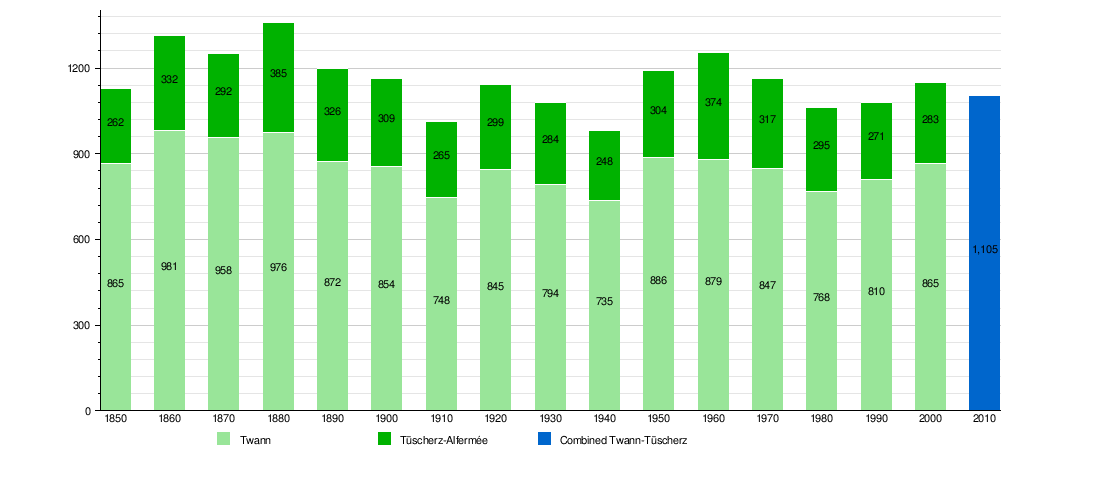
A Special World Heritage Site
Twann-Tüscherz is home to the Twann Bahnhof prehistoric pile-dwelling settlements. These are part of the Prehistoric Pile dwellings around the Alps UNESCO World Heritage Site. This means they are very important historical sites protected by UNESCO.
The Twann Bahnhof site is one of the best-dated prehistoric lakeside villages. Scientists used dendrochronological dating (studying tree rings) to find out when the wooden piles were used. They found dates from 3838 BC all the way to 3074 BC!
The site was found in the mid-1870s while digging a well. A big excavation happened in 1974-76. The site is thought to cover about 12,000 square meters (129,000 square feet). However, only about 1,200 square meters (12,900 square feet) were dug up in 1974-76. The parts of the site under the lake have not yet been explored.
Important Historical Buildings
Several buildings in Twann-Tüscherz are listed as important national heritage sites. These include the old Clunic Priory on St. Peter's Island, the former Thormanngut building, and the Fraubrunnen house. The villages of Tüscherz and Twann, and the small village of Wingreis, are also part of the Inventory of Swiss Heritage Sites.
How People Make a Living
In 2011, the unemployment rate in Twann-Tüscherz was low, at 1.76%. In 2008, about 422 people worked in the town.
- 132 people worked in the primary economic sector (like farming and fishing). There were about 50 businesses in this area.
- 51 people worked in the secondary sector (like manufacturing). There were 16 businesses in this area.
- 239 people worked in the tertiary sector (like services and tourism). There were 39 businesses in this area.
Many people travel to work. About 17.9% use public transportation, and 52.4% use a private car.
Religious Life
In 2000, most people (about 67.8%) belonged to a Protestant church. About 14.8% were Roman Catholic. About 11.2% said they did not have a religious affiliation.
Education in Twann-Tüscherz
In Twann-Tüscherz, about 53% of the people have finished non-mandatory upper secondary education. Also, 26.4% have completed higher education, like university or a specialized college.
The school system in the Canton of Bern starts with one year of optional Kindergarten. Then, students go to six years of Primary school. After that, there are three years of mandatory lower Secondary school. In this stage, students are grouped by their abilities. After lower Secondary, students can choose to continue their schooling or start an apprenticeship (learning a trade on the job).
During the 2009-10 school year, 137 students attended classes in Twann-Tüscherz. There were 2 kindergarten classes with 20 students. The town had 4 primary classes with 72 students. There were also 3 lower secondary classes with 45 students.
See also
 In Spanish: Twann-Tüscherz para niños
In Spanish: Twann-Tüscherz para niños





